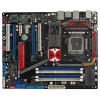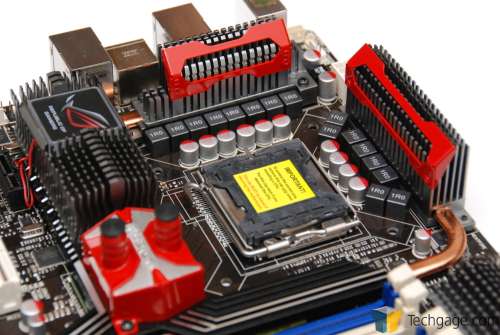- Qualcomm Launches Snapdragon 4 Gen 2 Mobile Platform
- AMD Launches Ryzen PRO 7000 Series Mobile & Desktop Platform
- Intel Launches Sleek Single-Slot Arc Pro A60 Workstation Graphics Card
- NVIDIA Announces Latest Ada Lovelace Additions: GeForce RTX 4060 Ti & RTX 4060
- Maxon Redshift With AMD Radeon GPU Rendering Support Now Available
ASUS Rampage Extreme

When the time came to design the Rampage Extreme, ASUS’ R&D went right to town. The X48-based board proves to be the most feature-packed one we’ve ever come across, and also one of the most overclockable. Aside from the robust design, water-cooled Northbridge and LCD Poster, the board even includes overclocking controls right on the PCB.
Page 10 – Power Consumption, Final Thoughts
To capture power consumption, we use a Kill-A-Watt, a cool gadget that plugs into your socket and reports the current wattage reading. We plug our testing machine directly into this, with our Gateway XHD3000 monitor plugged into the other available socket. Our results here show the power draw from the computer itself (including all internal components) and nothing else.
Please note that these figures also include the power draw from our Corsair Nautilus 500 water-cooling system, which gets its power from our PSU. Also, only one hard drive is connected to the motherboard and power supply, and the only ‘extra’ accessory used is the RAM fan. Before testing, network adapters are enabled, but no LAN cable is connected.
To record our results, we grab figures while the machine is completely idle, and then also while half of the processor (Core 2 Extreme QX9650 Quad-Core) is being utilized. The third and final set of results are grabbed while half of the CPU is being used in addition to the GPU (NVIDIA 9800 GTX), which represents a realistic result from normal gameplay.

Somewhat surprisingly, the Rampage Extreme managed to almost top the chart here, even when compared to other motherboards with an identical chipset. The only board to surpass it is eVGA’s 750i SLI FTW, but that’s thanks to its power-hungry Northbridge. It seems all those extra components on the Extreme make up for it, though, and it now makes sense why ASUS pushes the EPU technology so much.
Final Thoughts
Impossible: Recommending a $400 motherboard. It’s true… how could I reasonably recommend such an expensive motherboard? Truth is, I really can’t. But what’s important to note, is that while the board is expensive, it delivers enough to actually warrant the price tag… but like most things, it all depends on what you are looking for or expect.
Let’s start with the obvious… the overclocking-ability. ASUS really went to town with the Rampage Extreme, and it’s apparent the first time you enter the BIOS. The tweaking-ability caters to both the layman and the hardcore overclocker, and nobody will feel left out. Best of all, even if you feel overwhelmed by the sheer amount of options available, you can just wimp out (like me) and stick with what you know, and you’ll still be able to achieve a great clock.
Past that, the board is covered with more bling than a bad-boy hip-hop artist. Everywhere you look, there’s robust-looking heatsinks with cool red shrouds, an RoG emblem that glows even when the PC is turned off, a Northbridge water-block, replacement sinks, the LCD Poster and oh, let’s not forget the on-board overclocking controls.
If you don’t mind splurging on the most robust motherboard currently on the market, you won’t regret this one. It’s feature-packed, looks great and turned out to be one heck of an overclocking board. If I do have one notable gripe, it’s that the X-Fi audio card does not utilize an X-Fi chip. Rather, it uses emulated drivers that almost accomplish the same thing.
For the price, a real X-Fi card would have made the board even more reasonable, but I do know that Creative isn’t a company that particularly enjoys licensing out their chips to other companies, and that, to me, is undoubtedly the reason why a real X-Fi card is not used. At least ASUS did go as far as to include some emulation… that much in itself might be considered impressive.
-
Pros
- The board’s an overclocker’s dream.
- Feature-packed in every sense of the word.
- Solid performer.
- Unique features not found on other boards (on-board OC controls, LCD Poster).
- Northbridge can be water-cooled.
-
Cons
- $400 price tag is hard to swallow.
- X-Fi audio card isn’t a real X-Fi card.

Discuss in our forums!
If you have a comment you wish to make on this review, feel free to head on into our forums! There is no need to register in order to reply to such threads.
Support our efforts! With ad revenue at an all-time low for written websites, we're relying more than ever on reader support to help us continue putting so much effort into this type of content. You can support us by becoming a Patron, or by using our Amazon shopping affiliate links listed through our articles. Thanks for your support!






